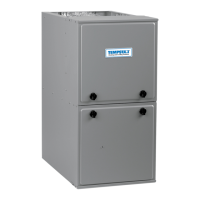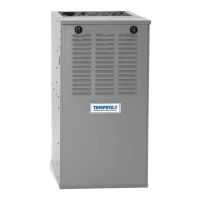N95ESN: Installation, Start-up, Operating and Service and Maintenance Instructions
Manufacturer reserves the right to change, at any time, specifications and designs without notice and without obligations.
53
Check Safety Controls
The flame sensor, gas valve, and pressure switch were all checked in the
Start-up procedure section as part of normal operation.
1. Check Main Limit Switch
This control shuts off combustion system and energizes
air-circulating blower motor, if furnace overheats. By using this
method to check the temperature limit control, it can be established
that the limit is functioning properly and that the limit will operate
if there is a restricted return-air supply or motor failure. If the limit
control does not function during this test, the cause must be
determined and corrected.
a. Run furnace for at least 5 minutes.
b. Gradually block off return air with a piece of cardboard or sheet
metal until the limit trips.
c. Unblock return air to permit normal circulation.
d. Burners will re-light when furnace cools down.
2. Check Pressure Switch(es)
This control proves operation of the draft inducer blower.
a. Turn off 115-v power to furnace.
b. Disconnect inducer motor lead wires from wire harness.
c. Turn on 115-v power to furnace.
d. Set thermostat to “call for heat” and wait 1 minute. When low
pressure switch is functioning properly, hot surface igniter
should NOT glow and control diagnostic light flashes a status
code 3. If hot surface igniter glows when inducer motor is
disconnected, shut down furnace immediately.
e. Determine reason low pressure switch did not function properly
and correct condition.
f. Turn off 115-v power to furnace.
g. Reconnect inducer motor wires, replace door, and turn on 115-v
power.
h. Blower will run for 90 sec before beginning the call for heat
again.
i. Furnace should ignite normally.
Checklist
1. Put away tools and instruments. Clean up debris.
2. Verify that the jumper is removed from the TEST/TWIN terminal.
Verify that there is nothing plugged into the PLT connector. (Note:
If there is a jumper connector plugged into PLT, remove it and
discard.) See Fig. 37.
3. Verify that the Blower/Heat Off Delay jumpers are set as desired.
See Fig. 37 and Fig. 72.
4. Verify that there are no unsealed openings in the blower shelf or
casing.
5. Verify that the blower (lower door in upflow position) and control
(“Main” or upper door in upflow position) doors are properly
installed.
6. Verify that the Status LED heartbeat (bright-dim). If not, check that
the power supply is energized and that the blower door is secure.
See Fig. 70 to interpret diagnostic codes.
7. Cycle test furnace with room thermostat to be sure that it operates
properly with the room thermostat. Check all modes including
Heat, Cool and Fan.
8. Check operation of accessories per manufacturer’s instructions.
9. Review Owner’s Manual with owner.
10. Attach entire literature packet to furnace.
Table 21 – Orifice Size and Manifold Pressure (in. w.c.) for Gas
Input Rate
40,000 BTUH to 140,000 BTUH
A11253A
Table 21 (Continued) -Orifice Size and Manifold Pressure (in. w.c.)
for Gas Input Rate (Cont.)
40,000 BTUH to 140,000 BTUH
A11253B
SAGLARUTANFOYTIVARGCIFICEPSSAG.GVA
HEAT VALUE 0.58 0.60 0.62 0.64
AT ALTITUDE Orifice Manifold Orifice Manifold Orifice Manifold Orifice Manifold
(Btu/cu ft) No. Pressure No. Pressure No. Pressure No. Pressure
900 43 3.8 42 3.2 42 3.3 42 3.4
092543 3.6 43 3.7 43 3.8 42 3.2
(0) 950 43 3.4 43 3.5 43 3.6 43 3.7
975 44 3.7 44 3.8 43 3.4 43 3.6
to 1000 44 3.5 44 3.6 44 3.8 43 3.4
1025 44 3.3 44 3.5 44 3.6 44 3.7
2000 1050 44 3.2 44 3.3 44 3.4 44 3.5
(610) 1075 45 3.7 45 3.8 44 3.3 44 3.4
1100 46 3.7 46 3.8 45 3.8 44 3.2
U.S.A. 800 42 3.4 42 3.5 42 3.6 42 3.7
2001 (611) 825 43 3.8 42 3.3 42 3.4 42 3.5
to 850 43 3.6 43 3.7 42 3.2 42 3.3
3000 (914) 875 43 3.4 43 3.5 43 3.7 43 3.8
900 44 3.7 44 3.8 43 3.5 43 3.6
Canada 925 44 3.5 44 3.6 44 3.8 43 3.4
2001 (611) 950 44 3.3 44 3.4 44 3.6 44 3.7
to 975 44 3.2 44 3.3 44 3.4 44 3.5
4500 (1372) 1000 44 3.0 44 3.1 44 3.2 44 3.3
775 42 3.3 42 3.4 42 3.5 42 3.6
3001 800 43 3.8 42 3.2 42 3.3 42 3.4
(915) 825 43 3.6 43 3.7 43 3.8 42 3.2
850 44 3.8 43 3.5 43 3.6 43 3.7
875 44 3.6 44 3.7 43 3.4 43 3.5
4000 900 44 3.4 44 3.5 44 3.7 44 3.8
(1219) 925 44 3.2 44 3.4 44 3.5 44 3.6
950 44 3.1 44 3.2 44 3.3 44 3.4
750 42 3.3 42 3.4 42 3.5 42 3.6
4001 775 43 3.7 43 3.8 42 3.3 42 3.4
(1220) 800 43 3.5 43 3.6 43 3.7 43 3.8
825 44 3.8 43 3.4 43 3.5 43 3.6
850 44 3.5 44 3.7 44 3.8 43 3.4
5000 875 44 3.3 44 3.5 44 3.6 44 3.7
(1524) 900 44 3.2 44 3.3 44 3.4 44 3.5
925 44 3.0 44 3.1 44 3.2 44 3.3
725 42 3.2 42 3.3 42 3.4 42 3.5
5001 750 43 3.7 43 3.8 42 3.2 42 3.3
(1525) 775
43 3.4 43 3.5 43 3.7 43 3.8
800
44 3.7 44 3.8 43 3.4 43 3.5
825 44 3.5 44 3.6 44 3.7 44 3.8
6000 850 44 3.3 44 3.4 44 3.5 44 3.6
(1829) 875 44 3.1 44 3.2 44 3.3 44 3.4
900 44 2.9 44 3.0 44 3.1 44 3.2
675 42 3.4 42 3.5 42 3.6 42 3.8
6001 700 42 3.2 42 3.3 42 3.4 42 3.5
(1830) 725 43 3.6 43 3.7 43 3.8 42 3.3
750 43 3.4 43 3.5 43 3.6 43 3.7
775 44 3.6 44 3.7 43 3.4 43 3.5
7000 800 44 3.4 44 3.5 44 3.6 44 3.7
(2133) 825 44 3.2 44 3.3 44 3.4 44 3.5
850 44 3.0 44 3.1 44 3.2 44 3.3
to
to
to
to
ALTITUDE
RANGE
ft (m)
U.S.A. and Canada
SINGLE-STAGE FURNACE
(TABULATED DATA BASED ON 20,000 BTUH PER BURNER, DERATED 2%/1000 FT (305M) ABOVE SEA LEVEL)
U.S.A. OnlyU.S.A. OnlyU.S.A. Only U.S.A. Only U.S.A. and Canada
SAGLARUTANFOYTIVARGCIFICEPSSAG.GVA
HEAT VALUE 0.58 0.60 0.62 0.64
AT ALTITUDE Orifice Manifold Orifice Manifold Orifice Manifold Orifice Manifold
(Btu/cu ft) No. Pressure No. Pressure No. Pressure No. Pressure
ALTITUDE
RANGE
ft (m)
SINGLE-STAGE FURNACE
(TABULATED DATA BASED ON 20,000 BTUH PER BURNER, DERATED 2%/1000 FT (305M) ABOVE SEA LEVEL)
650 42 3.4 42 3.5 42 3.6 42 3.7
7001 675 43 3.8 42 3.2 42 3.3 42 3.4
(2134) 700 43 3.5 43 3.7 43 3.8 42 3.2
725 44 3.8 43 3.4 43 3.5 43 3.6
750 44 3.5 44 3.7 44 3.8 43 3.4
8000 775 44 3.3 44 3.4 44 3.5 44 3.7
(2438) 800 44 3.1 44 3.2 44 3.3 44 3.4
825 44 2.9 44 3.0 44 3.1 44 3.2
625 42 3.4 42 3.5 42 3.6 42 3.7
8001 650 43 3.8 42 3.2 42 3.3 42 3.4
(2439) 675 43 3.5 43 3.6 43 3.7 42 3.2
700 44 3.7 43 3.4 43 3.5 43 3.6
725 44 3.5 44 3.6 44 3.7 44 3.8
9000 750 44 3.3 44 3.4 44 3.5 44 3.6
(2743) 775 44 3.0 44 3.2 44 3.3 44 3.4
9001 600 42 3.3 42 3.4 42 3.6 42 3.7
(2744) 625 43 3.7 42 3.2 42 3.3 42 3.4
650 43 3.5 43 3.6 43 3.7 43 3.8
675 44 3.7 44 3.8 43 3.4 43 3.5
10000 700 44 3.4 44 3.5 44 3.7 44 3.8
(3048) 725 44 3.2 44 3.3 44 3.4 44 3.5
* Orifice numbers shown in BOLD are factory-installed.
to
to
to
U.S.A. Only U.S.A. OnlyU.S.A. Only

